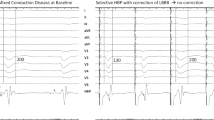Abstract
Background
Left bundle branch area pacing (LBBAP) is a newer technique to deliver more synchronous left ventricular activation. Several criteria have been proposed, but not fully validated, to confirm LBBAP during implantation of the pacing lead. Spectral analysis has been used to characterize the frequency components of the clinical QRS utilizing the Fourier transform algorithm. We hypothesized that higher frequency content of the paced QRS complex may show predictive value of successful LBBAP.
Methods
We evaluated 84 patients with ejection fraction > 50%, who underwent LBB lead placement (n = 42) using ≥ 1 current criteria and right ventricular midseptal (RVsp) lead placement (n = 42) from 2000 to 2022. Time frequency analysis (Matlab) was used to determine the frequency content of the paced QRS complex. The centroid frequency (CF), which is the weighted average QRS frequency, was calculated.
Results
Patients in RVsp group had a longer paced QRS duration (155.6 ± 28.0 vs 127.1 ± 17.2, p < 0.002) compared to the LBBAP group. Of all standard ECG leads, the paced QRS in V2 gave the greatest difference of the CF of the LBBAP group at 8.8 ± 1.6 Hz versus 5.7 ± 0.7 Hz of the RVsp group. This difference was significant by both univariate (p < 0.003) and multivariate (p < 0.010) analysis. Predictive value of the CF for successful LBB pacing in lead V2 was highest with an AUC of 0.98. The sensitivity and specificity were 88.1% and 97.6%, respectively.
Conclusion
Spectral analysis predicts successful LBBAP with higher frequency content when compared to RVsp pacing. Given the limitations to the current criteria to confirm LBBAP, intraprocedural use of frequency content analysis of the paced QRS complex in patients may prove useful at verifying LBB capture if verified by prospective clinical trials.


Similar content being viewed by others
References
Huang W, Su L, Wu S, et al. A novel pacing strategy with low and stable output: pacing the left bundle branch immediately beyond the conduction block. Can J Cardiol. 2017;33(12):1736.e1–3. https://doi.org/10.1016/j.cjca.2017.09.013.
Su L, Wang S, Wu S, et al. Long-term safety and feasibility of left bundle branch pacing in a large single-center study. Circ Arrhythm Electrophysiol. 14(2):e009261. https://doi.org/10.1161/circep.120.009261.
Zhang W, Huang J, Qi Y, et al. Cardiac resynchronization therapy by left bundle branch area pacing in patients with heart failure and left bundle branch block. Heart Rhythm. 2019;16(12):1783–90. https://doi.org/10.1016/j.hrthm.2019.09.006.
Scher AM, Young AC. Frequency analysis of the electrocardiogram. Circ Res. 1960;8:344–6. https://doi.org/10.1161/01.res.8.2.344.
Niebauer MJ, Rickard J, Polakof L, Tchou PJ, Varma N. QRS frequency characteristics help predict response to cardiac resynchronization in left bundle branch block less than 150 milliseconds. Heart Rhythm. 2014;11(12):2183–9. https://doi.org/10.1016/j.hrthm.2014.07.034.
Niebauer MJ, Rickard J, Tchou PJ, Varma N. Early changes in QRS frequency following cardiac resynchronization predict hemodynamic response in left bundle branch block patients. J Cardiovasc Electrophysiol. 2016;27(5):594–9. https://doi.org/10.1111/jce.12939.
Goldberger A, West BJ. Fractals in physiology and medicine. Yale J Biol Med. 1987;60:421–35.
Grossi S, Grassi F, Galleani L, Bianchi F, Masi AS, Contie MR. Atrial conduction velocity correlates with frequency content of bipolar signal. Pace. 2016;39:814–21.
Wu S, Chen X, Wang S, et al. Evaluation of the criteria to distinguish left bundle branch pacing from left ventricular septal pacing. JACC Clin Electrophysiol. 2021;7(9):1166–77. https://doi.org/10.1016/j.jacep.2021.02.018.
Hou X, Qian Z, Wang Y, Qiu Y, Chen X, Jiang H, Jiang Z, Wu H, Zhao Z, Zhou W, Zou J. Feasibility and cardiac synchrony of permanent left bundle branch pacing through the interventricular septum. Europace. 2019;21(11):1694–702. https://doi.org/10.1093/europace/euz188.
Li X, Li H, Ma W, Ning X, Liang E, Pang K, Yao Y, Hua W, Zhang S, Fan X. Permanent left bundle branch area pacing for atrioventricular block: feasibility, safety, and acute effect. Heart Rhythm. 2019;16(12):1766–73. https://doi.org/10.1016/j.hrthm.2019.04.043.
Zhang W, Huang J, Qi Y, Wang F, Guo L, Shi X, Wu W, Zhou X, Li R. Cardiac resynchronization therapy by left bundle branch area pacing in patients with heart failure and left bundle branch block. Heart Rhythm. 2019;16(12):1783–90. https://doi.org/10.1016/j.hrthm.2019.09.006.
Huang W, Chen X, Su L, Wu S, Xia X, Vijayaraman P. A beginner's guide to permanent left bundle branch pacing. Heart Rhythm. 2019;16(12):1791–6. https://doi.org/10.1016/j.hrthm.2019.06.016.
Punnusamy SS, Vijayaraman P. Evaluation of criteria for left bundle branch capture. Card Electrophysiol Clin. 2022;14:191–202.
Author information
Authors and Affiliations
Corresponding author
Ethics declarations
This article does not contain any studies involving human participants performed by any of the authors.
Ethical approval
Not applicable.
Conflict of interest
The authors declare no competing interests.
Additional information
Publisher’s note
Springer Nature remains neutral with regard to jurisdictional claims in published maps and institutional affiliations.
Rights and permissions
Springer Nature or its licensor (e.g. a society or other partner) holds exclusive rights to this article under a publishing agreement with the author(s) or other rightsholder(s); author self-archiving of the accepted manuscript version of this article is solely governed by the terms of such publishing agreement and applicable law.
About this article
Cite this article
Vajapey, R., Amuthan, R., Chung, M. et al. High predictive value of paced QRS frequency in verification of left bundle branch pacing. J Interv Card Electrophysiol 66, 2041–2046 (2023). https://doi.org/10.1007/s10840-023-01541-9
Received:
Accepted:
Published:
Issue Date:
DOI: https://doi.org/10.1007/s10840-023-01541-9




